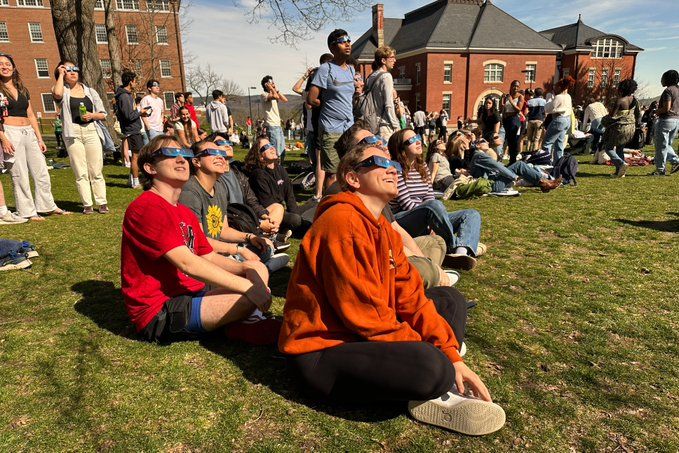College Observes Near-total Solar Eclipse
Community members and admitted students packed the quad and donned goggles to watch the eclipse, North America’s last for more than 20 years. Others made the three-hour drive north into the path of totality.

Amherst was graced by a near-total solar eclipse on Monday. At the eclipse’s peak, 3:27 p.m., the moon blotted out 94.6 percent of the sun’s diameter, bathing the jam-packed First Year Quad in an eerie light.
Students, faculty, staff, and prospective members of the class of 2028 — on campus for admitted students day — peered at the shrinking sun through Mammoth-branded eclipse glasses, breaking out into a round of applause as the eclipse approached its peak.
As the light diminished and the temperature dropped, community members expressed a range of reactions, from disinterest to existential awe.
“I feel very caveman-like,” said Matt Vitelli ’24.
“It’s one of those experiences that early humans and us both would be like, ‘Wow, the sun’s about to go dark because the moon is going in front of it,’” he said. “I think that’s very cool.”
Jacob Yang ’27 took a similarly matter-of-fact view but was less impressed.
“I don’t care at all — whatsoever,” he said. “It’s just the moon covering the sun.”
He was chided by his friend Cedric Jenkins ’27.
“I think it’s actually very important, and I was considering even driving three hours out of the way to get to the optimal location,” he said. “The issue with people these days is they don’t want to take initiative to go do things that they can’t do all the time … same thing with this eclipse. Go see the eclipse! What are you doing?”
Jenkins did not, however, drive to see the eclipse.
“I didn’t go because no one wanted to go with me,” he said.
He settled for a viewing from the quad.
Near the top of Memorial Hill, Lecturer in Art Zibby Jahns’ class was held outside for the day. Students suspended colanders and perforated pieces of paper from the trees, creating “pinhole cameras” that projected the sun’s crescent shape onto the ground.
“It’s getting colder even though it’s very sunny,” observed Jahns half an hour before the eclipse reached its peak.
“It’s also getting a little bit darker,” echoed one of their students.
Further down the hill, Phoebe Eccles ’24 gazed at the sun through “solar goggles” she had saved from North America’s last solar eclipse, in 2017.
Upon closer examination she realized that the glasses read, “Do not use after three years.”
She shrugged and looked back at the sun.
“The definition is fantastic,” she said.
Laying next to her, Lori Alarcon ’24, student body president, said that the only time she had seen so many students in one place was at last year’s White Out Rave.
“I think that says a lot about us,” she said, and observed that some students had pregamed the eclipse, too.
While students watched the eclipse, Be a Mammoth Day, the college’s open house for admitted students, carried on mostly as normal.
Prospective members of the class of 2028 and their parents bought merch from the Wheely Mammoth and filed behind tour guides, even as the eclipse neared its maximum.
Tour guide Avi Helft ’26 said he had difficulty keeping his audience’s attention.
“I was trying to talk about living in the Greenways, and everybody was just staring at the sky with their glasses on,” he said.
When he encountered the massive crowds at the top of Memorial Hill, just a few minutes before the peak, he decided to end the tour early.
One potential Mammoth stood near the war memorial, concerned that her father, whose massive DSLR was trained on the sun, would fry his lens.
She had not yet made her college decision but said she felt it was “auspicious” that Amherst’s admitted students day coincided with the eclipse.
She had previously toured on a weekend and appreciated seeing the campus come to life.
“It makes Amherst feel more familiar,” she said.
Jake Montes-Adams ’21, an admissions counselor, tempered expectations for eclipse-inspired commitments.
“We’re not sure if it will help us yield more students,” they said, “but it’s certainly going to make it a very memorable experience for everybody who comes today.”
Jerry Zhang ’25 was one of many students who left campus for the path of totality. Students visited friends and family in Vermont and Upstate New York, pitched tents for the night, or tagged along on a physics department-organized trip.
Zhang decided to view the eclipse with his sister, who attends Middlebury College, after a professor told him that the difference between near and complete totality was — Zhang’s words — “astronomical.”
“It made me think about why people believe in God,” Zhang said of the experience of near-total darkness. “If you’re some prehistoric civilization just seeing this out of nowhere, you’d start freaking out.”
Though he admitted that his own awe at the eclipse was somewhat reduced by his understanding of the physics behind it, Zhang said the drive was still worth it.
“The next total eclipse in the continental U.S. will be in 20 years,” he said. “Part of the reason why I justified going was that right now, my only stresses are midterms. In 20 years, I might have a family. I might have a full-time job. I think those will be even harder to make an excuse to get out of.”





Comments ()